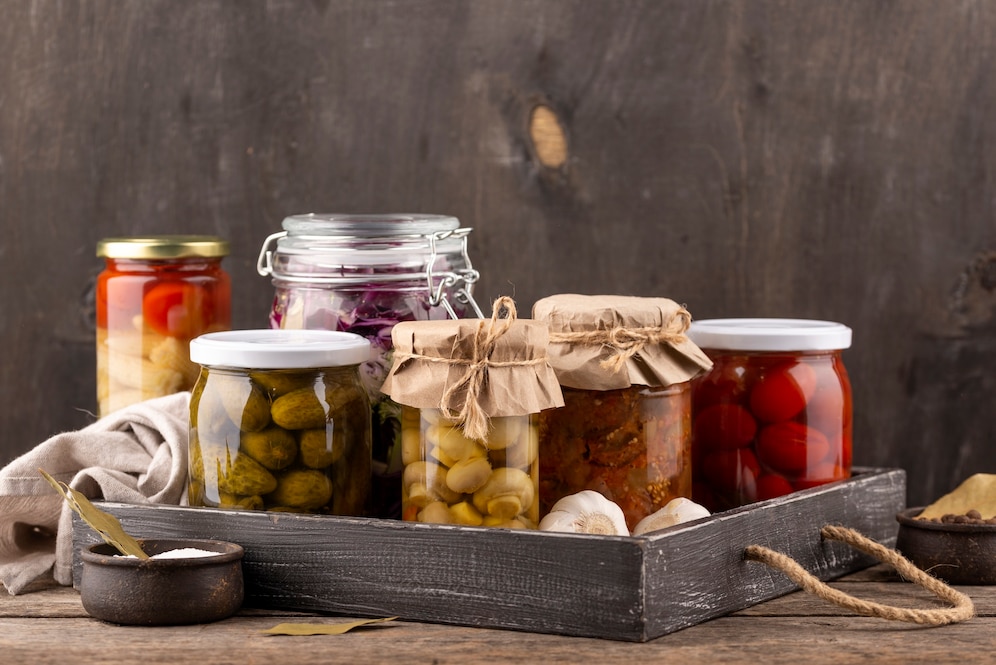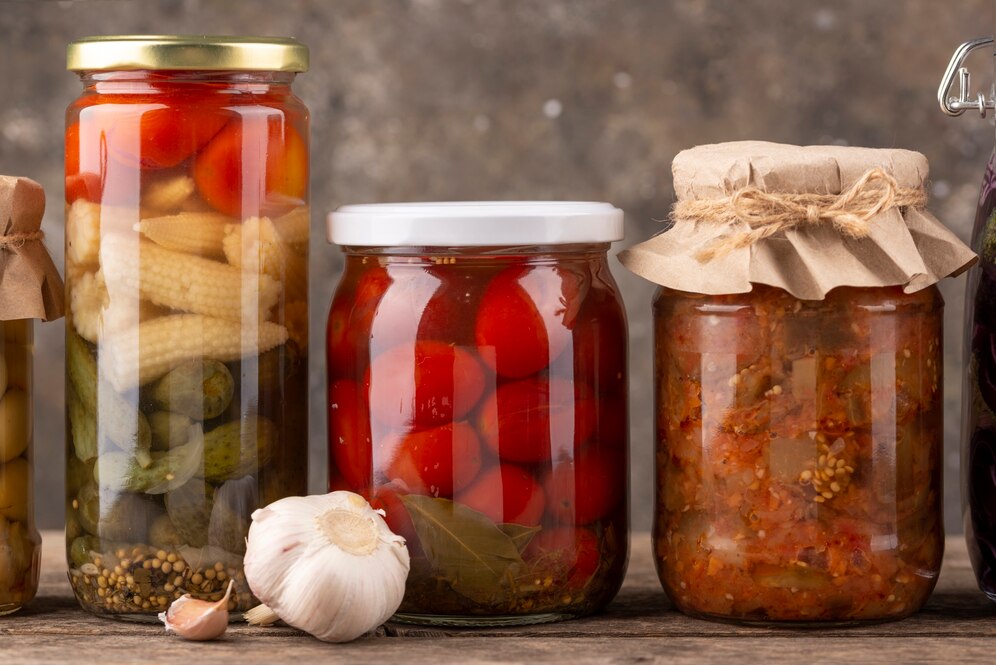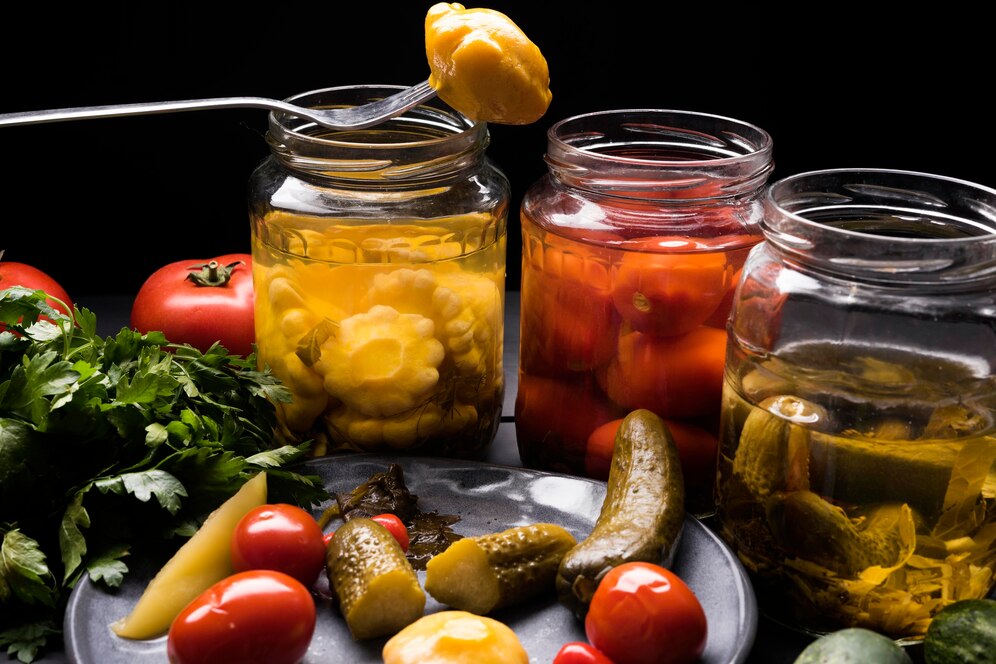The Food Blog

DIY Pickling: How Different Cultures Preserve Food
Pickling is an ancient method of preserving food that has been practised worldwide for generations. Immersing fruits, vegetables, and even meats in brine, vinegar, or fermented liquids has allowed people to prolong the shelf life of their food and improve its flavour.
From tangy dill pickles of North America to spicy Indian achaar and savoury umami-rich Japanese tsukemono, pickling varies in taste, texture and technique from one region to the next. In this guide, we’ll explore traditional pickling methods from different cultures, how they preserve food, and how you can recreate them at home.

The Basics of Pickling: Techniques and Ingredients
Pickling relies on two primary methods of preservation:
- Vinegar Pickling (Quick Pickling): Foods are preserved in an acidic solution, typically made with vinegar, salt, sugar, and spices. This process is fast and does not require fermentation.
- Fermented Pickling (Lacto-Fermentation): This method uses salt and natural bacteria to produce lactic acid, which preserves food and creates complex, tangy flavours over time.
Essential Ingredients for Pickling
- Base Ingredients include vegetables (cucumbers, carrots, cabbage), fruits (mangoes, lemons), or even meat and fish.
- Pickling Liquid: Vinegar, brine, or whey.
- Spices and Herbs: Dill, mustard seeds, peppercorns, garlic, and chilli flakes add flavour complexity.
- Salt: Key for lacto-fermentation, drawing out water and preventing spoilage.
Tip: Use non-iodised salt and filtered water for fermentation to avoid interfering with bacterial activity.

Pickling in Asia: Bold Flavours and Fermented Delights
India: Achaar (Spicy Pickles)
In India, pickling is an art form with regional flavour, ingredients, and spice level variations. Achaar is a spicy, tangy pickle made from mango, lime, garlic, or chilli. It is preserved in mustard oil, salt, and spices.
Traditional Method:
- The fruits or vegetables are salted and sun-dried to remove excess moisture.
- They are mixed with ground spices (turmeric, fenugreek, mustard seeds) and oil.
- The mixture is sealed in a jar and matures for weeks to months, creating a rich flavour.
How to Try It at Home:
- Use raw mangoes or limes with mustard oil and Indian spices.
- Let the jar sit in a warm, sunny spot for a week to develop flavours.
Japan: Tsukemono (Pickled Vegetables)
In Japan, tsukemono refers to a variety of pickled vegetables used as a side dish or garnish. The most common types include:
- Shibazuke: Pickled cucumbers and eggplants in red shiso leaves.
- Umeboshi: Salty, tangy pickled plums.
- Takuan: Yellow pickled daikon radish.
Traditional Method:
- Vegetables are salted and pressed under heavy weights to remove water.
- Pickling liquid (vinegar, brine, or sake lees) is added.
- The vegetables are left to ferment for days or weeks.
How to Try It at Home:
- Pickle cucumbers or radish in rice vinegar, salt, and sugar.
- Let them sit in the fridge for 3–7 days for a tangy flavour.
China: Sichuan Pickles
Chinese pickling is famous for its spicy and aromatic flavours, particularly in Sichuan cuisine. Pao cai (Sichuan pickles) are fermented in a salt brine with chillies, Sichuan peppercorns, and garlic.
Traditional Method:
- Vegetables such as cabbage, carrots, and daikon are washed and dried.
- They are submerged in a spicy, salty brine.
- The pickles are left to ferment for several days to weeks, creating a complex, tangy taste.
How to Try It at Home:
- Make a brine with water, salt, and Sichuan peppercorns.
- Add vegetables and let them ferment for 4–7 days.
Pickling in Europe: Preserving Seasonal Produce
Germany: Sauerkraut
In Germany, sauerkraut is a staple fermented dish made from shredded cabbage. It is prized for its tangy flavour and probiotic benefits.
Traditional Method:
- Cabbage is thinly sliced and salted.
- The mixture is packed into a jar or crock and pressed down to release natural juices.
- It ferments for 2–6 weeks, developing a tangy, complex taste.
How to Try It at Home:
- Shred cabbage and salt it generously.
- Pack it tightly into a jar, ensuring it is submerged in its liquid.
- Store it in a cool, dark place for 2–4 weeks.
Eastern Europe: Pickled Beets and Cucumbers
Pickling is a traditional method of preserving seasonal vegetables in Russia, Poland, and Ukraine. Pickled cucumbers and beets are popular staples.
Traditional Method:
- Vegetables are placed in jars with garlic, dill, and spices.
- A saltwater brine is added.
- The jars are sealed and left at room temperature for 1–2 weeks.
How to Try It at Home:
- Use small cucumbers or beets with garlic, dill, and peppercorns.
- Let them ferment in brine for 5–10 days.
Pickling in the Americas: Tangy and Sweet Variations
United States: Dill Pickles and Bread-and-Butter Pickles
In the US, pickling is associated with crispy dill pickles and sweet bread-and-butter pickles.
Traditional Method:
- Cucumbers are sliced and packed into jars with garlic, dill, and spices.
- A hot vinegar, salt, and sugar brine is poured over the vegetables.
- The jars are sealed and refrigerated or water-bath canned.
How to Try It at Home:
- Use cucumbers, garlic, and dill.
- Boil vinegar, salt, and sugar, and pour it over the cucumbers.
- Refrigerate for 48 hours before eating.
Mexico: Escabeche (Pickled Vegetables)
Mexican cuisine features escabeche, a mix of pickled carrots, onions, and jalapeños, often served as a condiment.
Traditional Method:
- Vegetables are blanched and placed in a jar.
- A hot brine made with vinegar, garlic, and oregano is poured over them.
- The jar is left to cool and marinate in the fridge.
How to Try It at Home:
- Use carrots, onions, and jalapeños.
- Pickle in a vinegar brine for 24–48 hours.
Conclusion: A World of Flavors Through Pickling

Pickling is a flavourful and practical way to preserve food enjoyed by cultures across the world. Pickling adds depth to your meals. Enjoy the spicy tang of Indian achaar, the crunchy zest of sauerkraut, or the aromatic kick of Sichuan pickles.
With a few simple ingredients and techniques, you can recreate these global pickling traditions at home, adding new flavours and probiotic benefits to your diet. Try different spices, brines, and veggies to find your unique pickled recipes.









